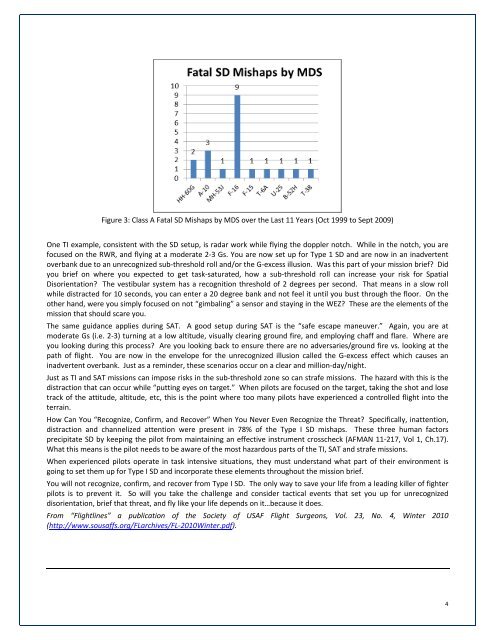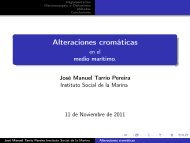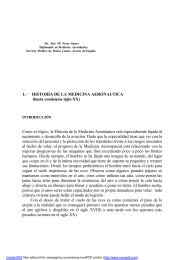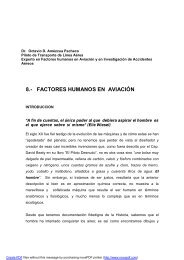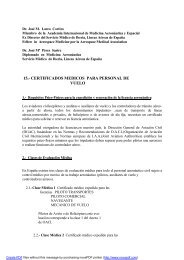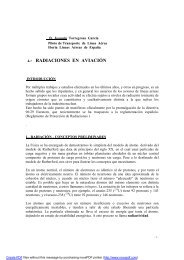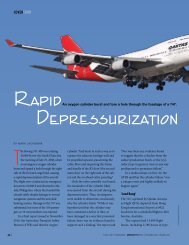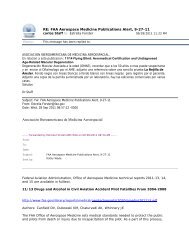AIMA Boletin Vol11 No2 (Diciembre/2010) - SEMA
AIMA Boletin Vol11 No2 (Diciembre/2010) - SEMA
AIMA Boletin Vol11 No2 (Diciembre/2010) - SEMA
You also want an ePaper? Increase the reach of your titles
YUMPU automatically turns print PDFs into web optimized ePapers that Google loves.
Figure 3: Class A Fatal SD Mishaps by MDS over the Last 11 Years (Oct 1999 to Sept 2009)<br />
One TI example, consistent with the SD setup, is radar work while flying the doppler notch. While in the notch, you are<br />
focused on the RWR, and flying at a moderate 2‐3 Gs. You are now set up for Type 1 SD and are now in an inadvertent<br />
overbank due to an unrecognized sub‐threshold roll and/or the G‐excess illusion. Was this part of your mission brief? Did<br />
you brief on where you expected to get task‐saturated, how a sub‐threshold roll can increase your risk for Spatial<br />
Disorientation? The vestibular system has a recognition threshold of 2 degrees per second. That means in a slow roll<br />
while distracted for 10 seconds, you can enter a 20 degree bank and not feel it until you bust through the floor. On the<br />
other hand, were you simply focused on not “gimbaling” a sensor and staying in the WEZ? These are the elements of the<br />
mission that should scare you.<br />
The same guidance applies during SAT. A good setup during SAT is the “safe escape maneuver.” Again, you are at<br />
moderate Gs (i.e. 2‐3) turning at a low altitude, visually clearing ground fire, and employing chaff and flare. Where are<br />
you looking during this process? Are you looking back to ensure there are no adversaries/ground fire vs. looking at the<br />
path of flight. You are now in the envelope for the unrecognized illusion called the G‐excess effect which causes an<br />
inadvertent overbank. Just as a reminder, these scenarios occur on a clear and million‐day/night.<br />
Just as TI and SAT missions can impose risks in the sub‐threshold zone so can strafe missions. The hazard with this is the<br />
distraction that can occur while “putting eyes on target.” When pilots are focused on the target, taking the shot and lose<br />
track of the attitude, altitude, etc, this is the point where too many pilots have experienced a controlled flight into the<br />
terrain.<br />
How Can You “Recognize, Confirm, and Recover” When You Never Even Recognize the Threat? Specifically, inattention,<br />
distraction and channelized attention were present in 78% of the Type I SD mishaps. These three human factors<br />
precipitate SD by keeping the pilot from maintaining an effective instrument crosscheck (AFMAN 11‐217, Vol 1, Ch.17).<br />
What this means is the pilot needs to be aware of the most hazardous parts of the TI, SAT and strafe missions.<br />
When experienced pilots operate in task intensive situations, they must understand what part of their environment is<br />
going to set them up for Type I SD and incorporate these elements throughout the mission brief.<br />
You will not recognize, confirm, and recover from Type I SD. The only way to save your life from a leading killer of fighter<br />
pilots is to prevent it. So will you take the challenge and consider tactical events that set you up for unrecognized<br />
disorientation, brief that threat, and fly like your life depends on it…because it does.<br />
From “Flightlines” a publication of the Society of USAF Flight Surgeons, Vol. 23, No. 4, Winter <strong>2010</strong><br />
(http://www.sousaffs.org/FLarchives/FL‐<strong>2010</strong>Winter.pdf).<br />
4


